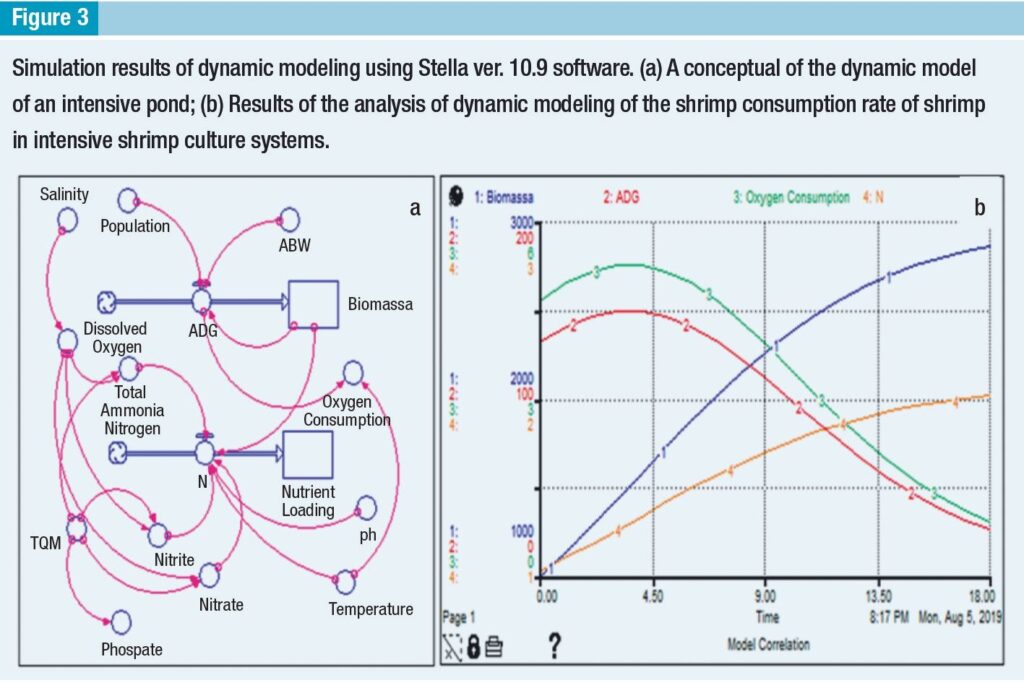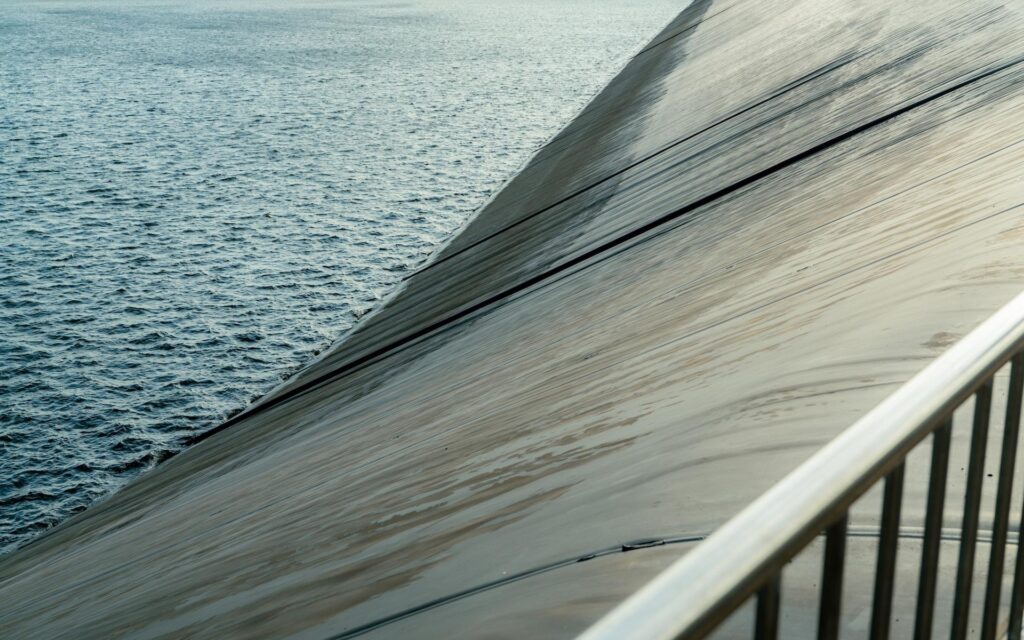By: Aquaculture Magazine Editorial Team*
In intensive shrimp culture, oxygen consumption of shrimp is an important indicator that greatly affects the physiological condition of shrimp as a reared organism. Here the results of a research that aimed to dynamically determine the oxygen consumption of shrimp in intensive culture as well as the variables of water quality and shrimp growth based on the Dynamic Modeling System.
Dissolved oxygen is the most crucial and dynamic water quality parameter in the culture system because aerobic organisms in the waters need oxygen rates that are sufficient for biochemical processes. The oxygen solubility in intensive ponds is mainly influenced by conditions of pH, temperature, salinity, turbulence and air pressure parameters. Dynamically, the dissolved oxygen concentration will fluctuate due to biological, physical and chemical processes.
In intensive cultivation, shrimp is an aquatic biota that requires oxygen for the process of bioenergy balance in its metabolic system. The rate of oxygen consumption greatly affects the condition of the shrimp metabolic system when it grows and has activities. The following results derived from a study that aimed to measure the dynamics of oxygen consumption by shrimp in intensive ponds and its relationship with variables of water quality and shrimp growth.

Methodology
This research was conducted in April-June 2019 or during the cultivation period of Litopenaeus vannamei in the intensive aquaculture area of Bayeman Village, Tongas District, Probolinggo Regency with the concept of ex-post-facto causal research design. Data collection in the form of oxygen consumption, biological growth and water quality were carried out every 10 days from the beginning of stocking to harvest.
The cultivation of L. vannamei was carried out in 2 ponds of 400 m2 of HDPE (high-density polyethylene) pond liners with a stocking density of 112 fish/m2 and the use of 4 hp waterwheels for each cultivation pond. The data of shrimp oxygen consumption rate were collected by random sampling, after which experimental trials were carried out using a 20 L aquarium and DO meter (AZ 8402, China).
The data of oxygen consumption rate of shrimp were collected experimentally, by randomly taking 4 shrimp from each pond, and the shrimp taken were the ones with complete body organs, active motion and full intestines.
The observation of water quality parameters such as pH, temperature, dissolved oxygen, and salinity was carried out in situ, while the observation of phosphate, nitrite, nitrate, total ammonia nitrogen (TAN), and total organic matter (TOM) has measured ex-situ at the BBPAP laboratory Situbondo every 10 days.
Results and discussion
The rate of oxygen consumption by shrimp during the growth period has a downward trend with the regression model Y = 9.444-0.047x. The highest rate of oxygen consumption is obtained at 0.450 mgO2/L, and the lowest was at 0.002 mgO2/L (Figure 1). This means that the heavier the shrimp weight, the lower the rate of oxygen demand needed.

This is because small shrimp need a higher energy for their metabolic system. In addition, the rate of oxygen consumption of shrimp is also influenced by environmental conditions such as temperature and salinity (Bett and Vinatea, 2009).
“The results of other studies stated that the minimum rate of oxygen consumption for shrimp in the juvenile phase is of 0.65 mg/L with an average weight of juvenile shrimp of 4.1g (Vinatea et al., 2009).”
In the graph of the weight and average daily gain of shrimp (Figure 2), it can be seen that the body weight of shrimp continues to increase from the initial period of cultivation to the harvesting. However, the average daily gain of shrimp appears to experience a decrease at the age of 50 days of cultivation, and after that it remains stagnant.

The growth stagnation at the age of 50 days is due to the high stocking density and biomass of shrimp in the ponds and the low levels of water salinity, which affect the biological growth conditions and the balance of osmoregulation system of the shrimp (Bray et al., 1994; Sookying et al., 2011; Chand et al., 2015).
These conditions genetically will also affect the level of molt-inhibiting hormone (MIH) expression at each phase of shrimp growth (Gao et al., 2016).
The rate of shrimp growth is exponential at the age of 30-50 days. By knowing the period of exponential growth rate of shrimp, it is expected that certain strategies or manipulation can be carried out to spur shrimp growth in that period. Engineering that might be done is to manipulate feeding habits and add supplements to the feed (Jayesh et al., 2015).
Based on the simulation analysis with the dynamic modeling concept, it is shown that oxygen consumption was linear to the dynamics of average daily gain and inversely proportional with the increasing rate of shrimp biomass in the ponds (Figure 3).

It means that the rate of shrimp consumption will experience a fluctuation in accordance with the growth rate of shrimp because during the process of shrimp growth, physiologically it is necessary to have sufficient oxygen levels to fulfill their metabolic activity. The dissolved oxygen rate required for the metabolic process of adult shrimp at a stable temperature of 280-33°C is 1.49 mg/L (Niu et al., 2003).
The increase in shrimp biomass, which is described as having a sigmoidal growth curve, during the cultivation period, will have an impact on the increasing level of nutrient accumulation.
The increase in nutrient accumulation will create over-enrichment of excess in the pond water environment (Wu et al., 2014). The waters that are rich in excess nutrients will cause plankton blooms in the ponds and an imbalance of the habitat ecosystem (Muendo et al., 2014). In addition, plankton blooms will also affect the grazing activities of plankton in the food chain in the ponds.
In addition, the oxygen consumption rate of shrimp in intensive ponds had a close relationship with water salinity and total organic matter. Based on data on the water quality variable, the rate of oxygen consumption has a negative correlation to salinity and TOM parameters.

Also, it does not correlate with other water quality parameters. The negative relationship to the water salinity parameter indicates that the fluctuation of mineral ions in the ponds greatly affects the rate of oxygen consumption by shrimp metabolism for the osmoregulation mechanism (Re and Diaz, 2011).
The increased rate of oxygen consumption is a physiological response of shrimp to maintain their body condition to remain in a homeostatic condition due to fluctuations in water salinity levels (Hernandez et al., 2005).
“Meanwhile, the increasing levels of organic matter due to the increase in shrimp biomass will affect the level of increased oxygen demand in the sediment and water column for the respiration process of organisms (Luong et al., 2016; Leduc and Pilditch, 2017).”
For the variable of the biological growth of shrimp, the rate of oxygen consumption has a close relationship to the average body weight of shrimp but does not have a close relationship with the average daily gain. This is because, during their life, the rate of oxygen consumption of shrimp at each growth phase or each body weight has different oxygen demand ratios (Budiardi et al., 2005).
Small shrimp have a higher probability of oxygen consumption for their metabolic activity (Djawad and Jompa, 2002). Different rates of oxygen consumption in the metabolic system at each stage of organisms’ growth are also predicted as a form of physiological and behavioral adaptation responses (Kieffer and Wakefield, 2009; Bouyoucos et al., 2018)
Conclusion
Based on the results of the study, it can be concluded that dynamically fluctuations in oxygen consumption and average daily gain of shrimp in intensive culture are closely influenced by the stability of water quality conditions in the shrimp habitat.

This article is sponsored by: REEF INDUSTRIES INC.

This is a summarized version developed by the editorial team of Aquaculture Magazine based on the review article titled “OXYGEN CONSUMPTION OF LITOPENAEUS VANNAMEI IN INTENSIVE PONDS BASED ON THE DYNAMIC MODELING SYSTEM” developed by: WAFI, A. – Universitas Ibrahimy, ARIADI, H. – Universitas Pekalongan, MUQSITH, A. – Universitas Ibrahimy, MAHMUDI, M. and FADJAR, M. – Universitas Brawijaya. The original article, including tables and figures, was published on FEBRUARY, 2021, through JOURNAL OF AQUACULTURE AND FISH HEALTH.
The full version can be accessed online through this DOI: 10.20473/jafh.v10i1.18102










